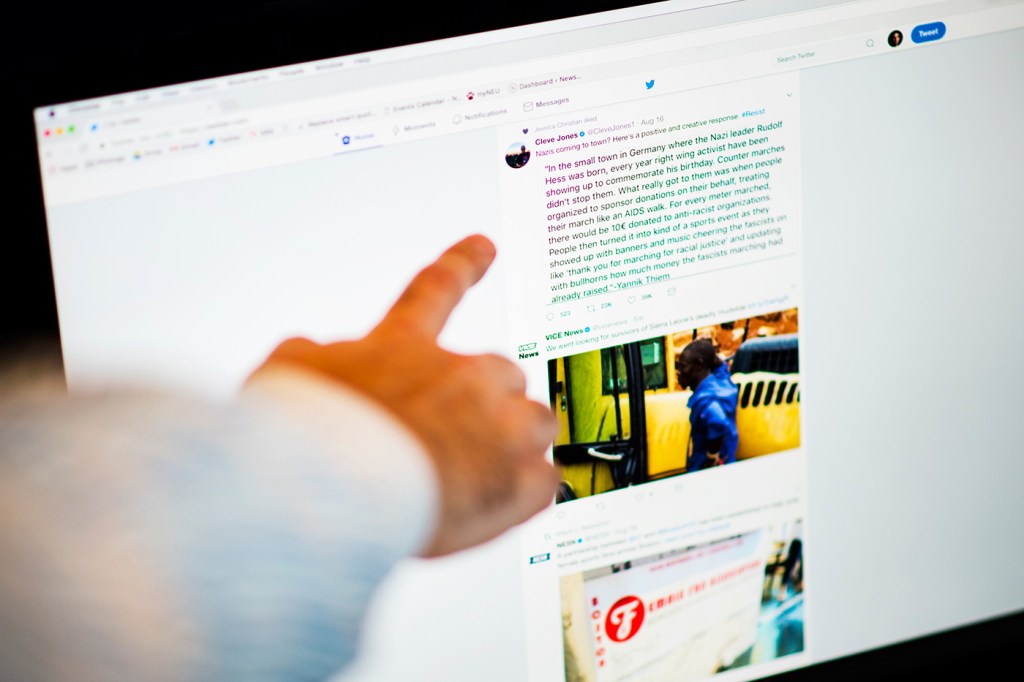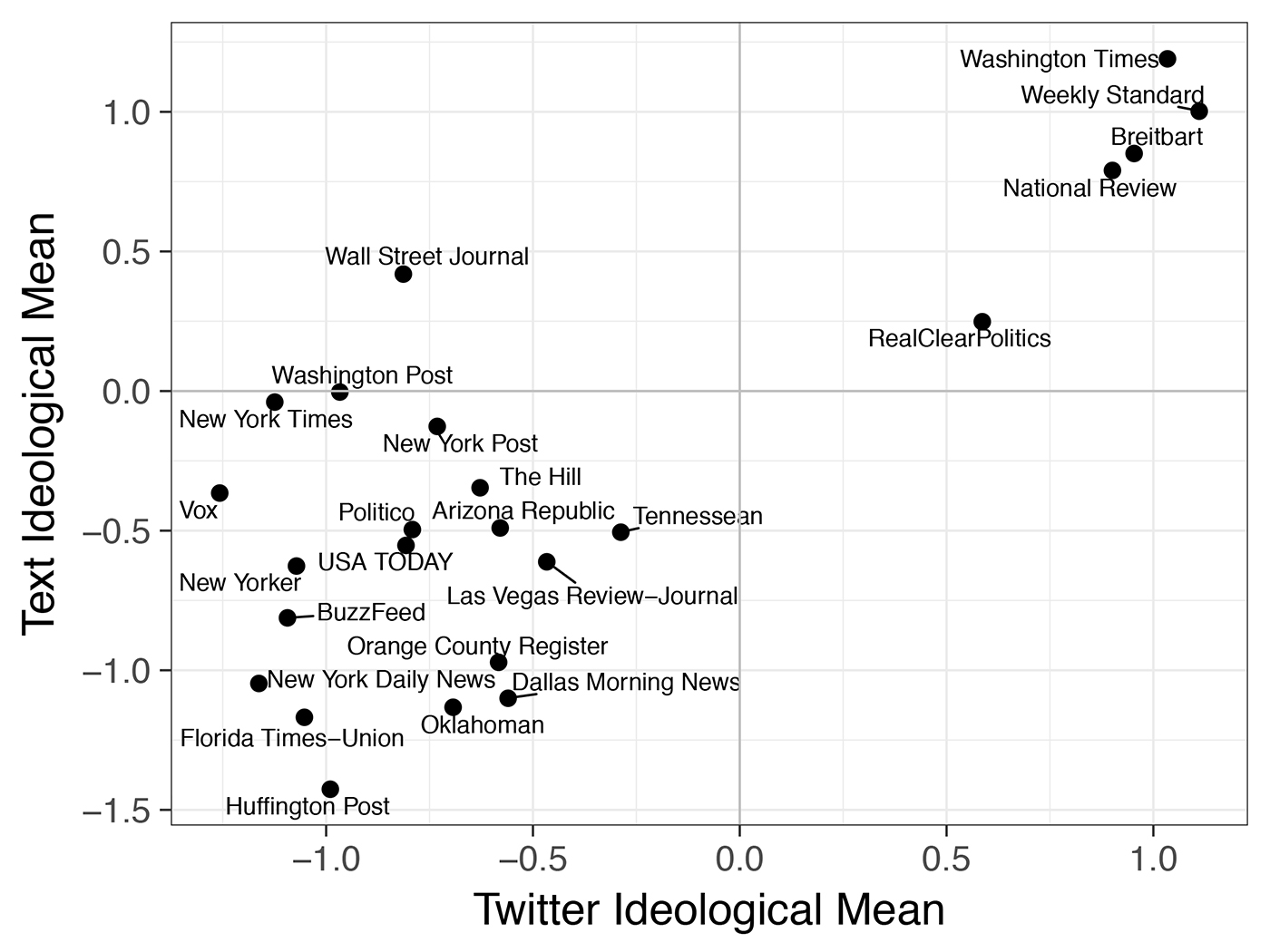Study finds ‘modest correlation’ between journalists’ social networks and ideology of their news content

In a new study, an interdisciplinary team of Northeastern University researchers has found a “modest correlation” between a journalist’s Twitter network and the ideological dimensions of his or her news content. The researchers emphasized that while their work doesn’t show causation, it does represent “a crucial first step toward greater critical examination of emerging patterns of media bias.”
“Twitter is very much the watercooler for the journalism profession these days, and journalists spend an awful lot of time there,” said co-author John Wihbey, assistant professor of journalism. Political polarization and media bias are issues of intense debate today, and Wihbey said the findings could bring more scrutiny to the way the media sources information and publishes content. “It’s always good to reflect on the kinds of sources we have and information inputs we have,” he said.
Wihbey added that the study illustrates a broader issue in the media about the need for journalists to be more in touch with diversity of experience and views across America. He pointed to a Nieman Lab story last year about digital news pushing the industry into tighter geographic clusters; this new study, he said, focuses on the narrowness of journalists’ online-social “geography.”
Twitter is very much the watercooler for the journalism profession these days, and journalists spend an awful lot of time there.
John Wihbey
assistant professor of journalism
The research team comprised Wihbey; David Lazer, Distinguished Professor of Political Science and Computer and Information Science; and postdoctoral research fellow Kenny Joseph and data scientist Thalita Dias Coleman, who work in Lazer’s lab and Northeastern’s Network Science Institute. Wihbey presented the team’s research at the KDD Data Science + Journalism Workshop/Conference in Halifax, Canada, on Monday.
The researchers said their work provides, to their knowledge, the first empirical study of journalists’ online social networks and the connections with professional output. “The novel aspect of our research was connecting these two modes of data: who a journalist follows on Twitter, and what they write,” Joseph said.
For the study, the researchers examined more than 502,000 news articles produced by 1,047 journalists at 25 different news outlets. The news outlets cut across a wide spectrum—The Washington Times and Breitbart among the “heavily right leaning”; the New York Post, The Wall Street Journal, The Dallas Morning News, and The Oklahoman, among the “right leaning”; The Huffington Post, Vox, and Politico among the “heavily left leaning”; and USA Today, Bloomberg, Buzzfeed, The New York Times, and The Washington Post among the “left leaning.”
Not surprisingly, the data showed that overall journalists from left-leaning outlets have a left-leaning followership, and the same was true for reporters at right-learning news organizations. There were some exceptions, however, such as Jeremy Peters, a New York Times reporter who frequently covers Republicans.

The researchers determined the ideology of journalists’ Twitter networks by developing a method that factors in the journalists, the congressional accounts they follow, and other politically active Twitter accounts.
As part of their methodology to assess whether reporters’ news content was left- or right-leaning, the researchers constructed a set of phrases that are representative of left- or right-leaning ideology. To do this, they examined about 150,000 congressional public statements, extracted a variety of phrases, and then scored those phrases based in part on how often they were used and in what context. Of the final list of 114 phrases used for their assessment, 57 were left-leaning and 57 were right leaning. Among the top “left-leaning” phrases were “LGBT,” “bigotry,” and “voting rights act”; among the top “right-leaning” phrases were “bureaucrats,” “overreach,” and “illegal immigrants.”
Then, the researchers analyzed the usage of these terms in journalists’ news content to scale how left- or right-leaning their coverage was.
While the researchers found “a clear correlation between the ideology of the journalist’s Twitter network and the ideology of his or her writing,” they underscored several notable outliers. For example, New York Times reporter David Sanger focuses heavily on national security and military affairs and wouldn’t be characterized as particularly partisan among media observers. But the researchers’ analysis put Sanger among the most right-leaning media producers, even though his Twitter network leaned left. There were “a substantial number” of other journalists, the researchers said, whose content leaned right but whose Twitter followership leaned left.
What’s more, the researchers wrote, the study can’t fully account for “confounding variables” such as a journalist’s beat—which would demand the reporter be embedded deeper in specific ideological communities as part of his or her sourcing and research.
The authors noted that previous research has suggested journalists as a whole tend to lean more left and that reporters are generally concentrated in metropolitan areas, which tend to vote more liberally. These factors could help explain why their social networks skew in that direction. The researchers added that the findings give tentative evidence to impartiality remaining strong in journalistic culture, despite criticisms that journalists are mostly liberal and are therefore biased.
“The relationship between social networks and work output of journalists is complex and evolving, and the moderate correlation and obvious exceptions found point to that reality,” they wrote.





